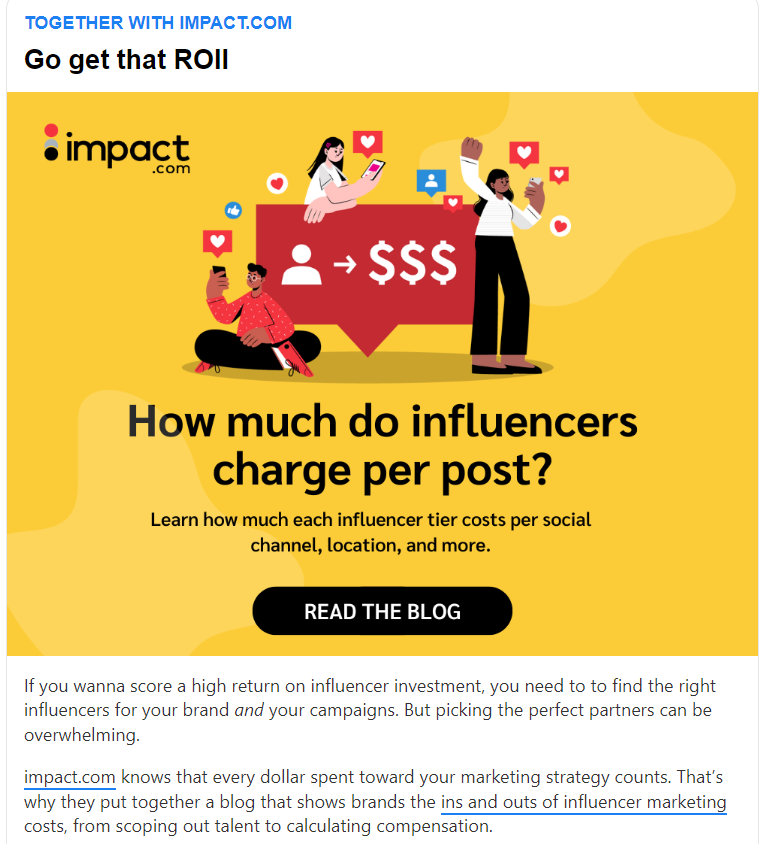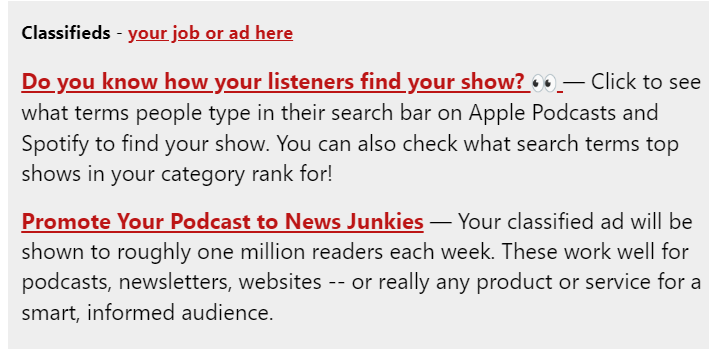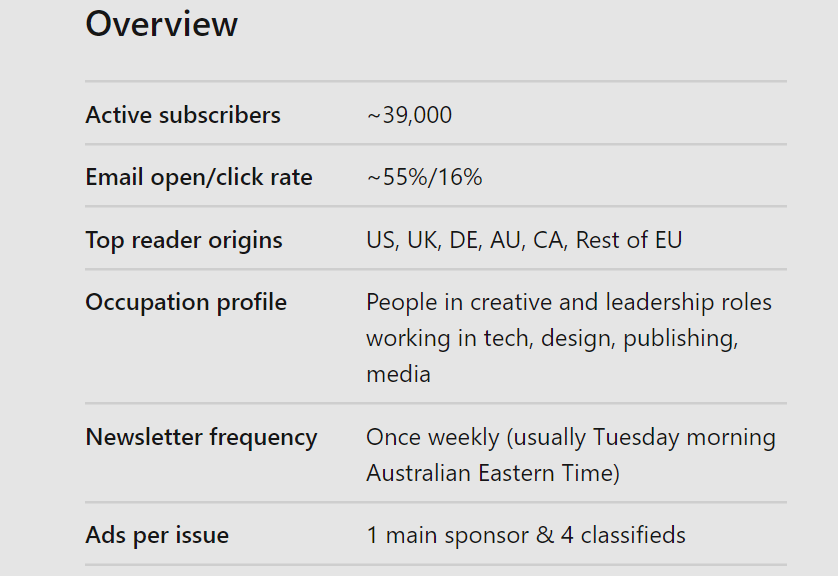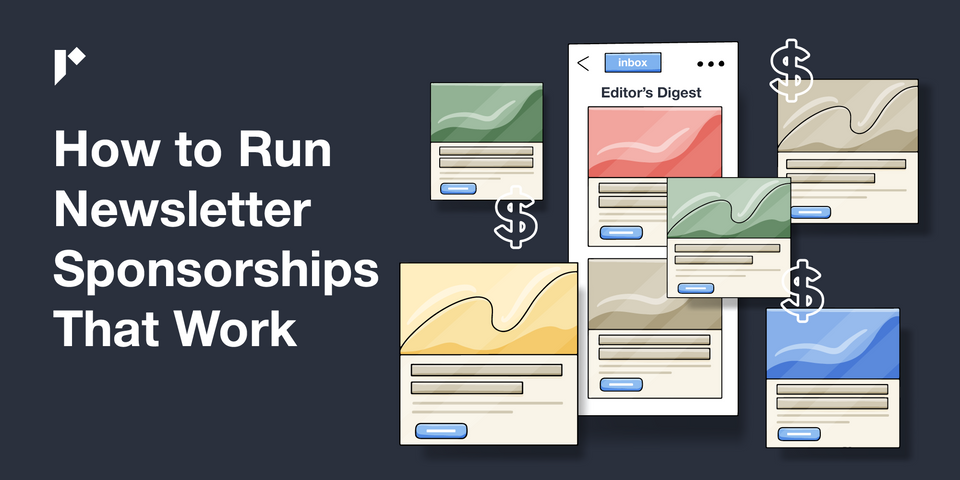All those 'soothsayers' that sounded the death knell for email must be eating their words by now. Globally, more than 4 billion people have email accounts, and together they send around 333 billion emails a day.
So it's no surprise that brands, bloggers, entrepreneurs and creators of all kinds have gathered subscribers keen to hear more. Newsletters have become a valuable marketing strategy, but did you know that newsletter sponsorship is also on the rise?
Done right, sponsored newsletters can be a win-win as a revenue stream for the creator and a goldmine of qualified leads for the sponsor.
Table of Contents
What are newsletter sponsorships?
A newsletter sponsorship is short, enticing copy placed inside another creator's newsletter. Paid sponsorships often outperform social media ads when you choose newsletters that match your target audience.
They can be more efficient than website ads too, partly because people often use ad blockers and don't even see most ads. Other people are so used to advertisements that they develop so-called ad blindness and don't even notice yours.
However, email newsletters are invited into people's inboxes so they're more likely to open and read them. So when you sponsor newsletters you can reach many consumers who'll be interested in your service or product.
Newsletter sponsorship examples
Some newsletters have multiple sponsors - for example, Josh Spector's newsletter, 'For the Interested.'

Other newsletters, like Morning Brew, offer one large segment of sponsored content per issue.

Newsletter creators may also offer classified ads, like this example from Podnews.

Ways to sponsor email newsletters
Sponsored newsletters
These are brief email ads placed inside another creator's newsletter (as in the examples above.) Some newsletters run sponsorships as classified ads, while other advertisers prefer to pay more for a featured header.
Pros:
- A small paid newsletter advertisement is cheaper than a dedicated email (see below.)
- You connect with engaged audiences who have signed up to get that newsletter
- Opt-in newsletters bypass ad blockers and spam filters so you can be confident that people will see your ad if they open the newsletter.
Cons:
- You may be competing for the same potential customers as other advertisers in that issue.
- Even the most dedicated newsletter subscribers don't always open their mail.
- Many of the email subscribers who read the newsletter won't click on an ad link.
Dedicated email
Similar to sponsored blog posts, dedicated emails are all about your brand or business. You create the brand content and readers get it delivered to their inbox as an email newsletter from the creator.
Pros:
- If your ad copy is particularly relevant to the newsletter's target audience you could gain an excellent conversion rate from running sponsored content.
- You're not competing with other advertisers or even with content from the newsletter creator, so every link goes to your business.
- Dedicated emails can be more creative with their presentation, including images, GIFs and videos.
- Some newsletters have massive subscriber numbers, so you could reach millions.
Cons:
- Subscribers may be annoyed when they get unasked-for marketing in the guise of sponsored content. Some may even unsubscribe in protest.
- A dedicated sponsored email will cost far more than a one-liner
- Creating a dedicated email takes more time and effort than a short advertisement.
How much does a newsletter sponsorship cost?
The pricing structure for email newsletter sponsorship campaigns varies tremendously amongst newsletters. Some charge a flat fee, while others use CPM or cost per mille calculated as (ad cost/impressions or subscribers) x 1000 to determine newsletter ad rates.
Of course, there are many variables to consider when calculating the value of a newsletter sponsorship campaign.
- Do the reader demographics align with your target audience?
- What are the newsletter's engagement metrics?
- What do they provide advertisers, and how much work will you have to do as a sponsor?
- What are the subscriber numbers, and what do those numbers mean regarding your industry? E.g., a thousand subscribers would be minuscule numbers in the fashion or entertainment industries. However, those same numbers would be huge in a tiny niche.
- What can you afford to pay? Let's say you run a course business and charge $2000 per course. If a newsletter sponsorship costs $500 and you got two conversions, you've made $3500 - an excellent investment. However, if your courses cost $100 each, you'd need to get five sales to break even.
More and more newsletter creators are making things easy for sponsors by providing a media kit. These include information like the newsletter's subscriber numbers, the open rate, reader origins and demographics, the advertising styles they accept, social media links etc. Some media kits include a booking form, making it easy for potential sponsors to either book a slot or join a waiting list.

How to discover the best newsletters to sponsor
As with any marketing strategy, an effective newsletter sponsorship campaign needs careful planning. So, before you leap into booking newsletter ads, think about these points:
1. Know your target audience
You can only run a successful campaign if you're targeting the right audience. Are you targeting B2C or B2B customers? What are their demographics? Hobbies? Buying power?
If you haven't already got a clear idea of who you're trying to reach, it's worth taking some time to get it right. Figuring out exactly who your target audience is will mean analyzing your current customer base and website analytics, as well as researching competitors.
2. Identify a measurable goal
Newsletter sponsorships only work if you have a clear, attainable goal in mind. Do you want to:
- Gain qualified leads?
- Get more subscribers for your own newsletter?
- Make sales directly from the sponsored content?
- Introduce a new product or service to a highly targeted audience?
- Increase exposure for your brand or business in your industry's niche?
- Stand out from the crowd?
3. Research suitable newsletters using Reletter
Reletter's email newsletter database lists thousands of newsletters. You can use our search filters to sift out newsletters by name, publisher, subscriber numbers, engagement, gender skew, publishing frequency and more.
Click on a specific newsletter title, and Reletter brings up a wealth of extra data. You'll find links to past issues, website URLs, social media platforms, email contacts and more.
4. Design effective creative copy
Compelling ad copy conveys value and appeals to readers' emotions in as few words as possible. Every word counts, particularly if your campaign centers around one-liner ads.
In dedicated newsletter emails, colors, patterns, shapes and images work together to catch the readers' attention and lead them to click on the link to purchase, subscribe or learn more.
5. Track your ad's performance
Depending on your newsletter sponsorship goal you can measure success or failure via the following:
- click through rates on your ads
- the number of new leads generated (track them via a unique newsletter code)
- sales numbers
- new visitors who subscribe to your newsletter
- rise in activity on other channels, e.g., your social media accounts.
Final thoughts
With Reletter, discovering new opportunities to meet your target audience has never been easier.


